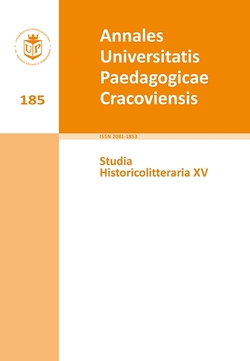Szeregowiec Ryan, czyli wojna i (a) pamięć
Main Article Content
Abstract
Saving Private Ryan. War and (vs) memory
The analysis is concerned with the relations between representation of war in American cinema and its cultural memory based on Steven Spielberg's Saving Private Ryan (USA 1998). Based on concepts such as cultural memory, postmemory, representation and realism, multiple aspects of a film work were analyzed: the plot, image, sound, and John Williams' musical score. Hollywood war films through referencing genre traditions, patriotic musical style and iconic imagery are capable of influencing the ways society remembers and imagines war. In case of Saving Private Ryan filming techniques used for the combat scenes play a particular role. Influenced by the original World War II combat documentaries the filmmakers achieved the viewer's full immersion in depicted combat, as opposed to the older war cinema, where technological means allowed the camera to only observe the events.
Key words: combat film; Saving Private Ryan; Steven Spielberg; collective memory; representation;
Downloads
Article Details

This work is licensed under a Creative Commons Attribution-NonCommercial-NoDerivatives 4.0 International License.
COPYRIGHT POLICY
The publisher of "Annales Universitatis Paedagogicae Cracoviensis.Studia Historicolitteraria" is authorised to use and distribute all the materials published in the journal on the basis of a non-exclusive licence agreement unlimited in time – previously concluded for an indefinite period of time each time with the author of a specific paper in the fields of exploitation specified in the agreement.
OPEN ACCESS POLICY
"Annales Universitatis Paedagogicae Cracoviensis.Studia Historicolitteraria” is an open access journal, and all its contents are available for free to users and/or their institutions on the basis of non-exclusive licenses under Creative Commons (CC BY CC-BY-4.0). Users can read, download, make copies, distribute, print, search, or to link to full text articles in this journal without the prior permission of the publisher or the author.This is consistent with the definition of open access BOAI (http://www.soros.org/openaccess).
References
Assman J., Pamięć kulturowa. Pismo, zapamiętywanie i polityczna tożsamość w cywilizacjach starożytnych, przeł. A. Kryczyńska-Pham, Warszawa 2008.
Barthes R., Dyskurs historii, przeł. A. Rysiewicz, Z. Kloch, „Pamiętnik Literacki” 1984, z. 3.
Basinger J., The World Wawr II Combat Film. Anatomy of a Film Genre, New York 1986.
Bodnar J., „Saving Private Ryan” and Postwar Memory in America, „The American Historical Review” 2001, nr 3.
Burch N., Theory of Film Practice, przeł. z francuskiego H. R. Lane, wstęp A. Michelson, London 1973.
Burch N., Theory of Film Practice, trans. Helen R. Lane, introduction by Annette Michelson, London 1973.
Hamon P., Ograniczenia dyskursu realistycznego, przeł. Z. Jamrozik, „Pamiętnik Literacki” 1983, z. 1.
Hirsch M., Generation of Postmemory, „Poetics Today” 2008, nr 1.
Markowski M. P., O reprezentacji, [w:] Kulturowa teoria literatury, red. M. P. Markowski, R. Nycz, Kraków 2010.
Morawski S., O realizmie jako kategorii estetycznej, „Estetyka” 1961.
Plesnar Ł. 100 filmów wojennych, Kraków 2002.
Ricoeur P., Pamięć, historia, zapomnienie, przeł. J. Margański, Kraków 2012.
Spielberg S., wypowiedź na okładce [w:] J. Williams, Saving Private Ryan. Music from the Motion Picture, Dreamworks 1999.
Stroiński P., „Pojedynek żołnierza Chrystusowego” Wacława Potockiego – emblemat czy nie?, [w:] Ut pictura poesis/ut poesis pictura. O związkach literatury i sztuk wizualnych od XVI do XVIII wieku, red. A. Bielak, Warszawa 2013.
Van Tieghem P., Główne doktryny literackie we Francji, przeł. M Wodzyńska, E. Maszyńska, Warszawa 1971.
Traba R., Wstęp do wydania polskiego, [w:] Pamięć kulturowa. Pismo, zapamiętywanie i polityczna tożsamość w cywilizacjach starożytnych, red. J. Assmann, przeł. A. Kryczyńska-Pham, Warszawa 2008.
